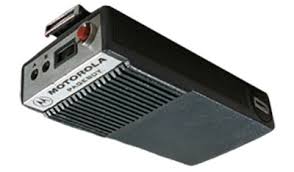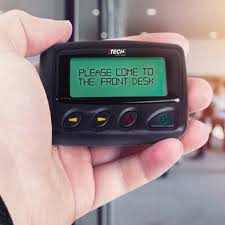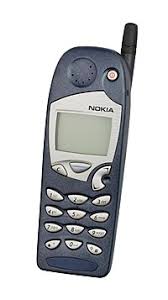The Pager
Pagers, or beepers, were radio-like systems developed for quick communication between workers in various fields. These mini radio devices came along in the 1950s and picked up heavily in the 1980s and 1990s. Pagers dominated the communication industry before the mobile cellphones and email came to be. However, now with texting, email, and numerous other forms of instant communication, the pager has quickly fallen off. In this research paper, I will dive into the creation of the pager, how it impacted life and labor industries, and finally how the demand for pagers declined.
Creation
The first radio system that resembled the pager was put in place by the Detroit Police Department in the early 1920s (Gibson). Using radios and walkie-talkies, the policemen in scout cars were able to remain in contact with the department headquarters. However, this pager-like system was somewhat different from the pagers that were developed later on; this system relied on one-way radio communication receivers, or AM (Global Data Burst). In 1949, Al Gross invented the very first telephone pager (Bellis). These pagers were patented and used in New York City’s Jewish Hospital. However, during most of the 1950s, pagers were only used by doctors, as they had not yet been approved by the Federal Communications Commission (FCC). Finally, in 1958, the FCC approved pagers for public use (Jowitt).

It was not until 1964 that the first consumer pager was introduced: the Motorola Pageboy I (Bellis). This first pager could not store or display messages, but it played a tone that signified the action that should be taken. In the 1970s, voice pagers were introduced, which could send and play audio messages along with the tone. By the 1980s, there were upwards of 3 million pagers in use worldwide (Global Data Burst). Prior to this time, there were limited ranges in which pagers could be used, so they were often limited to hospitals and other workplaces. However, wide-area paging was inventing in the 1980s, allowing a large growth in usage of pagers (Bellis). Communication via pagers peaked in the late 1980s to the 1990s, as more than 60 million pagers were being used worldwide. However, as mobile cellphones began to come along in the 1990s, pagers were beginning to see the end of their usage.

Impact
The impact of pagers was most immediately felt in hospitals by doctors and nurses, as these professions were the first to use the new pager technology. The pager presented various improvements to the hospital labor industry (Motorola Solutions). For example, improved and faster communication between doctors and nurses was a huge improvement. Being able to quickly notify a doctor to return to the hospital is essential in time sensitive cases, and pagers were the first real technology that allowed this. This additionally removed the loudspeaker system, which played a message for doctors or nurses over a speaker to be heard by anyone in the hospital, often causing an annoyance to both doctors and patients.
Pagers also allowed the boundaries between home life and work life to significantly blur, bringing work into personal lives more often, no matter the profession (Kaufman-Scarborough). As pagers became more commonplace in all industries, employees were reachable wherever they were. This wave of technology that included pagers, fax machines, and later email considerably increased the regularity of working at home.
Decline
By the 2000s, the usage of pagers started to transfer to the usage of mobile cellphones. Motorola stopped producing pagers in 2001 (Bellis). The market for the pagers industry began to grow flat by 2002, and decline soon after (Datamonitor). Mobile cellphones that were being manufactured during this time incorporated the same aspects that pagers were known for: quick messaging between two parties. These handheld devices not only included functions present in the pager, but additional functions all in one place as well, such as calling and email capabilities. The convenience of these devices began to take over the pager market, and therefore we have seen the mobile device become the main tool used for communication purposes today (Jowitt). However, pagers are still being used, although rarely, due to their reliability and network. Cellphones still rely on a good connection or Wifi to send these messages. However, paging networks allow messages to be delivered instantly, with no lag, something that cellphones cannot always offer (Bullis). Due to the reliable pager networks, pagers are still rarely being used in a few professions.

Conclusion
Pagers, being created alongside radio communication devices, were one of the first, and most reliable, communication devices of the 20th century. Although its reliability has kept it somewhat alive today, society’s need for convenience and ease of communication has forced the move to mobile devices, such as cellphones. The pager simply cannot compete with the vast amount of communication opportunities that cellphones, tablets, and computers provide. Although it has lost its place in the world of communication and technology today, the pager will go down as one of the most influential pieces of old technology to be created.
Works Cited
“A Short History Lesson on Pagers #ThrowbackThursday.” Global Data Burst, www.globaldataburst.com/news/the-history-of-pagers-throwbackthursday.
• This website gives short descriptions of the history of the pager in the United States. It is helpful because it provides a good amount of information regarding the dates of when the pager was first used, patented, etc., but in a concise manner.
Bellis, Mary. “Pagers: Instant Contact Before the Age of Cell Phones.” ThoughtCo, ThoughtCo, 10 Sept. 2018, www.thoughtco.com/history-of-pagers-and-beepers-1992315.
• This article, similar to the first website, breaks down the development, evolution, and downfall of the pager. This website was helpful because it goes a little more in depth regarding how Motorola cornered the market when the first consumer pager was created, and also talks about how the pager has become obsolete in today’s society.
Gibson, Stephen W. Cellular Telephones and Pagers: An Overview. Newnes, 1997.
• This source is a book that dives into the history and development of communication devices such as radio, cellphones, and pagers. This source is reputable because it was a published book, and although it seems as though it is geared towards a more technically advanced audience, it was still very helpful to get some insight into how the pager came to be.
Jowitt, Tom. “Tales In Tech History: The Pager.” Silicon UK, Silicon UK, 5 Nov. 2019, www.silicon.co.uk/mobility/smartphones/tales-tech-history-pager-204285.
• This website was another source that vaguely looked at the history and development of the pager. This source was helpful because of how it looked at how the pager grew in demand over the late 1900s, growing rapidly between the 80s and 90s.
Kaufman-Scarborough, Carol. “Time Use and the Impact of Technology.” Time & Society, vol. 15, no. 1, 2006, pp. 57–80., doi:10.1177/0961463x06061782.
• This is a journal that researched and looked into how technology blurred the lines between work life and personal life and the time/space relationship. This source did not focus directly on the pager, so it did not provide a ton of information, but it did give that insight that the pager contributed to the movement of working from home.
Motorola Solutions. “Motorola History - The Handie-Talkie Pager Newsreel” Youtube, uploaded by Motorola Solutions, 28 June 2011, https://www.youtube.com/watch?v=rHqLixYhbXs
• This source is an old informational video about Motorola’s “Handie-Talkie”. This provided some insight into how Motorola envisioned their new communication technology being used in hospitals, and is reputable because it was posted directly by Motorola Solutions.
Pagers Industry Profile: United States. Datamonitor Plc. Print.
• This source is a market overview from 2003 of the pager industry in the United States. It was unique because instead of looking from the beginning of the process, this market overview allowed me to look at the end of the pager’s life, and how the downward trends corresponded with the growth in cellphone usage.